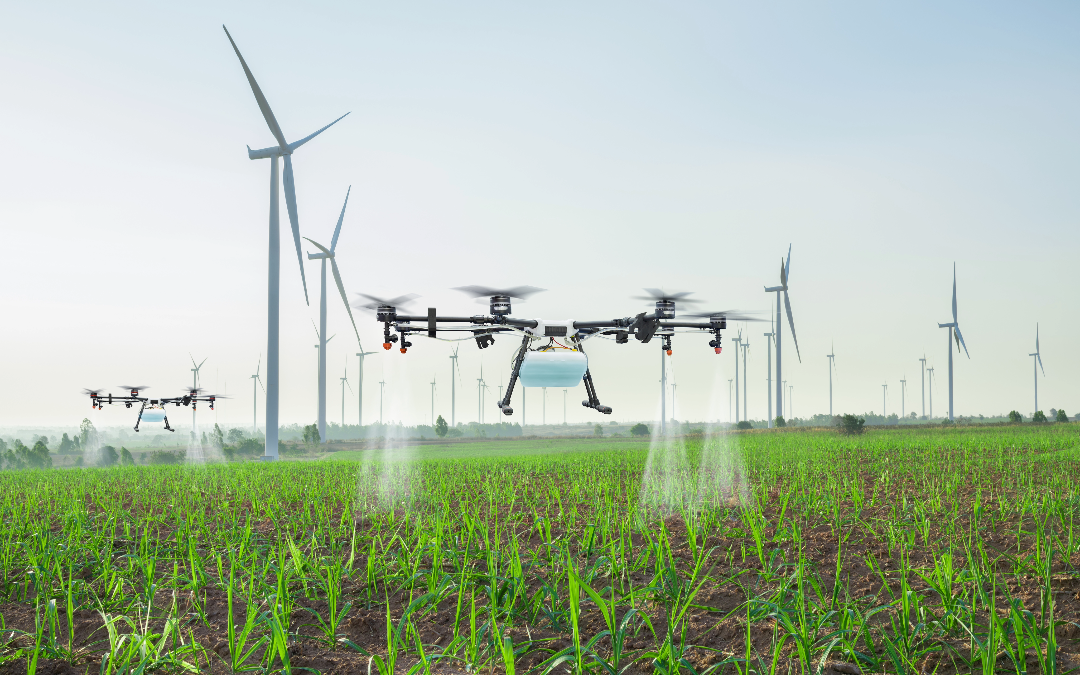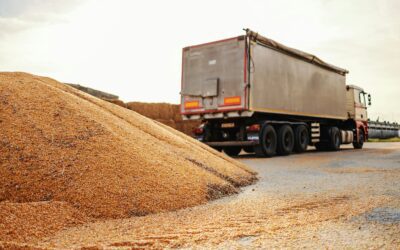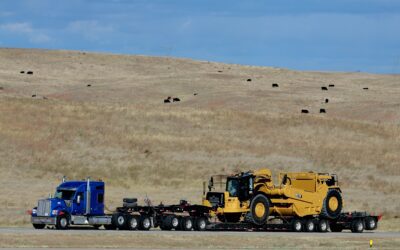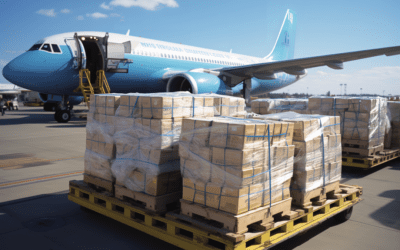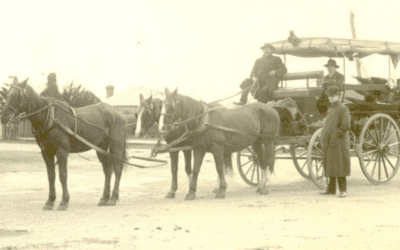The agriculture industry is the backbone of our global economy, providing food, feed, fiber, and fuel for the world’s population. In recent years, the sector has seen significant transformations driven by technological advancements, environmental concerns, and changing consumer preferences. As we approach 2024, it’s essential to take a closer look at the agriculture industry’s past trends and what the freight industry can expect in the near future. Get ready to explore the evolution of agriculture, highlight key statistics, and predict trends that will shape the freight industry in 2024.
Technology that drives efficiency
This technology is making an impact today and can be even more useful in the future. Take a look at some of the new key tools that are making farming what it is today and shaping it for the future.
- Drones
Drones have impacted almost every industry imaginable, including agriculture. Farmers can monitor soil health, determine water stress, optimize field management, analyze crop health, and keep an eye on potential threats to their crops or livestock.
- GPS
These receivers have become increasingly popular on sprayers, combines, and various types of equipment over the last several years. Farmers can now use satellites to map fields, guide equipment, and even monitor livestock.
- Precision techniques
Along with drones and GPS, the ag industry is beginning to rely on remote sensing technology, variable rate applications, and even autonomous vehicles.

The farming revolution
This trend has allowed farmers to scale up their operations, reduce labor costs, and improve overall productivity. In the United States, farmer numbers declined as output increased over time.
It involves organic methods, fewer chemicals, and precision techniques to reduce waste and impact. The USDA states, “Sustainable agriculture frequently encompasses a wide range of production practices, including conventional and organic. A regionally integrated system of plant and animal production practices are designed to produce long-term results.” These results can include:
- Producing enough human food, feed, fiber, and fuel to meet the needs of rising populations
- Protecting the environment and promoting the expansion of natural resource supplies
- Sustaining the economic viability of agriculture systems
Sustainable practices enhance efficiency, productivity, and profitability industry-wide.
Sustainability drives eco-friendly farming
A more robust global trade economy has expanded agriculture beyond local, regional, or even domestic markets. As countries depend on exports and imports, the US is part of a vast global food system. The global food supply chain has become more complex and interconnected. As written in The International Agriculture Law Center, “The U.S. Department of Agriculture’s (USDA’s) Foreign Agricultural Service (FAS) reports that the United States is one of the world’s largest agricultural exporters, with more than 20% of domestic agriculture production volume being exported each year.”
Pricing: Current Trends and Future Outlooks
In June, the USDA released its cost-of-production forecast for major field crops. This gave insight into expected expenses for 2023 and 2024. For 2024, production costs for major crops like corn, soybeans, wheat, cotton, rice, and peanuts should stay fairly high.
Expectations are for only a slight decrease, ranging from 3.6% lower for corn to 1.4% lower for soybeans. Input costs for 2024 should rank as the third-highest on record. Only 2022 and 2023 had higher input costs.
Mixed Cost Outlook for 2024
Examining the various input cost categories, the outlook from 2023 to 2024 presents a mixed picture. Interest expenses per acre are projected to drop by roughly 30%, while fertilizer expenses are expected to decrease by 17%, and chemical expenses are forecasted to decline by nearly 8%. Land expenses are also anticipated to dip by 1.4%. However, other significant expenses, such as seed costs, labor, machinery and equipment, taxes, and insurance, are poised for increases during this period. These dynamics collectively shape the financial landscape for agriculture in the upcoming year.
For 2024, the cost-of-production is estimated to be highest for rice, reaching nearly $1,200 per acre, which represents a 1.8% decrease from 2023. Following rice, peanut input costs are projected at $1,172 per acre, showing a 1.6% decrease, while the cotton cost-of-production is forecasted to be $866 per acre, down by the same percentage. Producing one acre of corn is estimated at a cost of $856 per acre, reflecting a 3.6% decrease, and for soybeans, the projected cost of production is $613 per acre, experiencing a 1.4% reduction. Among these major field crops, wheat is expected to have the lowest cost-of-production at $416 per acre, representing a 2.3% decrease from the previous year. These figures underscore the financial complexities and challenges that farmers in various segments of the agriculture industry will face in the year 2024.
Below are the production costs over the year and the estimates for 2024:

Agriculture and the Supply Chain
To understand the current state of the agriculture industry and its implications for the freight sector, let’s delve into some key statistics and trends:
- Global Food Demand
The world’s population is expected to reach approximately 9.7 billion by 2050. This demographic growth will drive an increased demand for food and agricultural products, creating a larger demand for transportation.
- Technology Adoption
Precision agriculture, biotechnology, and data analytics are becoming increasingly prevalent. These technologies enable farmers to optimize crop yields and reduce resource usage, which, in turn, affects transportation needs.
- Sustainability
Sustainability concerns have led to a growing interest in organic farming, regenerative agriculture, and eco-friendly practices. Freight carriers will need to adapt to transport more diverse agricultural products.
- Climate Change
Erratic weather patterns and climate change are posing challenges to agriculture. Extreme weather events can disrupt supply chains and transportation networks, affecting the timely delivery of agricultural goods.
- Supply Chain Resilience
The COVID-19 pandemic exposed vulnerabilities in global supply chains, including those in agriculture. Freight companies are likely to focus on building more resilient supply chains to mitigate future disruptions.

Predictions for the Freight Industry in 2024
Now, let’s look ahead and make some predictions about what the freight industry can expect in 2024 concerning the agriculture sector.
- An increased demand for refrigerated transportation.
As the global population grows and consumer preferences shift towards fresh and perishable products, the demand for refrigerated transportation services will continue to rise. This will be particularly important for transporting fruits, vegetables, dairy products, and other temperature-sensitive goods.
- A growing reliance on supply chain digitization.
The adoption of digital technologies in agriculture and freight will lead to more efficient supply chains. Real-time tracking, blockchain for supply chain transparency, and predictive analytics will become standard practices, enhancing visibility and reducing inefficiencies.
- More focused, tailored sustainability initiatives.
Consumers are increasingly concerned about the environmental impact of their purchases. This will drive the adoption of greener transportation options in agriculture, such as electric and hydrogen-powered trucks. Freight companies will need to invest in eco-friendly technologies to meet market demands.
Key Agricultural Freight Trends on the Horizon
- A new spotlight on precision delivery.
Precision agriculture techniques will extend beyond the farm gate and into transportation. Data-driven route optimization, load matching, and predictive maintenance will enable more efficient and cost-effective delivery of agricultural products.
- More attention to resilience planning.
The lessons learned from the COVID-19 pandemic will encourage the development of more resilient supply chains. Freight companies will invest in contingency planning, redundancy, and risk mitigation strategies to ensure the consistent delivery of agricultural goods, even in the face of unforeseen disruptions.
- Robust planning for trade dynamics.
International trade in agricultural products will continue to expand. Freight carriers will need to adapt to changing trade dynamics and regulations, which may require them to navigate evolving tariff structures and import/export requirements.
- A restructuring and need for shortened supply chains.
In response to sustainability concerns and the desire for fresher products, there may be a trend towards shorter supply chains. This could lead to increased demand for regional transportation networks, reducing the need for long-distance freight.
- Reduced waste through communication.
Collaboration and transparency between farmers, shippers, and logistics providers will become more common in the coming year. This will result in more efficient transportation networks and reduced waste in the supply chain, making it necessary to create longevity for individual businesses and the industry as a whole.
KCH Transportation and the Agriculture Industry
The agriculture industry is at the nexus of several critical global challenges, including feeding a growing population, mitigating climate change, and ensuring food security. As we approach 2024, the freight industry will play a pivotal role in supporting the agricultural sector’s continued growth and adaptation to changing circumstances.
To thrive in this evolving environment, freight companies must embrace technology, prioritize sustainability, and build resilient supply chains. By staying ahead of the curve and adapting to emerging trends, the freight industry can not only meet the evolving needs of the agriculture sector but also contribute to a more sustainable and efficient food supply chain for the world.
If you’re looking for a reliable partner in the supply chain, contact our team today!

